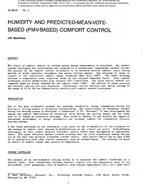Description
The effect of comfort control on cooling season energy requirements is described. Two comfort control strategies are investigated and compared to a conventional temperature control system. The purpose of the comfort control strategies is to maintain uniform comfort levels during periods of plant operation throughout the entire cooling season. One strategy is based on control of the theoretical comfort index, Predicted Mean Vote (PMV) . The other strategy utilizes a temperature reset algorithm based on the internal humidity level. Both comfort strategies utilize proportional plus integral (PI) controllers. The three control methods are compared based on energy consumption and comfort level (PMV). The effects of plant oversize and internal sources are also presented. Preliminary results indicate that energy savings in the range of 5% to 14% are theoretically possible with comfort control strategies.
Units: SI
Citation: Symposium, ASHRAE Transactions, 1986, vol. 92, pt. 1B, San Francisco
Product Details
- Published:
- 1986
- Number of Pages:
- 13
- File Size:
- 1 file , 4.1 MB
- Product Code(s):
- D-SF-86-01-1




